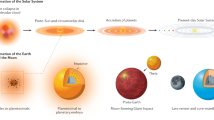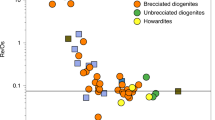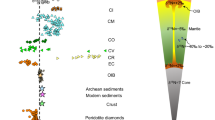Abstract
The Earth formed through the accretion of numerous planetary embryos that were already differentiated into a metallic core and silicate mantle. Prevailing models of Earth’s formation, constrained by the observed abundances of metal-loving siderophile elements in Earth’s mantle, assume full metal–silicate equilibrium, whereby all memory of the planetary embryos’ earlier differentiation is lost1,2. Using the hafnium–tungsten (Hf–W) and uranium–lead (U–Pb) isotopic dating systems, these models suggest rapid accretion of Earth’s main mass within about 10 million years3,4,5,6 (Myr) of the formation of the Solar System. Accretion terminated about 303,7 or 1004,5 Myr after formation of the Solar System, owing to a giant impact that formed the Moon. Here we present geochemical models of Earth’s accretion that preserve some memory of the embryos’ original differentiation. These disequilibrium models allow some fraction of the embryos’ metallic cores to directly enter the Earth’s core, without equilibrating with Earth’s mantle. We show that disequilibrium models are as compatible with the geochemical observations as equilibrium models, yet still provide bounds on Earth’s accretion and core formation. We find that the Hf–W data mainly constrain the degree of equilibration rather than the timing, whereas the U–Pb data confirm that the end of accretion is consistent with recent estimates of the age of the Moon8,9. Our results indicate that only 36% of the Earth’s core must have formed in equilibrium with Earth’s mantle. This low degree of equilibration is consistent with the siderophile element abundances in Earth’s mantle.
This is a preview of subscription content, access via your institution
Access options
Subscribe to this journal
Receive 12 print issues and online access
$259.00 per year
only $21.58 per issue
Buy this article
- Purchase on Springer Link
- Instant access to full article PDF
Prices may be subject to local taxes which are calculated during checkout




Similar content being viewed by others
References
Wade, J. & Wood, B. J. Core formation and the oxidation state of the Earth. Earth Planet. Sci. Lett. 236, 78–95 (2005).
Corgne, A., Keshav, S., Wood, B. J., McDonough, W. F. & Fei, Y. Metal–silicate partitioning and constraints on core composition and oxygen fugacity during Earth accretion. Geochim. Cosmochim. Acta 72, 574–589 (2008).
Jacobsen, S. B. The Hf–W isotopic system and the origin of the Earth and Moon. Annu. Rev. Earth Planet. Sci. 33, 531–570 (2005).
Halliday, A. N. A young Moon-forming impact at 70–110 million years accompanied by late-stage mixing, core formation and degassing of the Earth. Phil. Trans. R. Soc. A 366, 4163–4181 (2008).
Halliday, A. N. & Wood, B. J. How did Earth accrete? Science 325, 44–45 (2009).
Yin, Q. et al. A short timescale for terrestrial planet formation from Hf–W chronometry of meteorites. Nature 418, 949–952 (2002).
Albarède, F. Volatile accretion history of the terrestrial planets and dynamic implications. Nature 461, 1227–1233 (2009).
Touboul, M., Kleine, T., Bourdon, B., Palme, H. & Wieler, R. Late formation and prolonged differentiation of the Moon inferred from W isotopes in lunar metals. Nature 450, 1206–1209 (2007).
Touboul, M., Kleine, T., Bourdon, B., Palme, H. & Wieler, R. Tungsten isotopes in ferroan anorthosites: Implications for the age of the Moon and lifetime of its magma ocean. Icarus 199, 245–249 (2009).
Rubie, D. C., Nimmo, F. & Melosh, H. J. Treatise on Geophysics Ch. 9.03, 51–90 (Elsevier, 2007).
Stevenson, D. J. Treatise on Geophysics Ch. 9.01, 1–11 (Elsevier, 2007).
Kleine, T. et al. Hf–W chronology of the accretion and early evolution of asteroids and terrestrial planets. Geochim. Cosmochim. Acta 73, 5150–5188 (2009).
Kleine, T., Münker, C., Mezger, K. & Palme, H. Rapid accretion and early core formation on asteroids and the terrestrial planets from Hf–W chronometry. Nature 418, 952–955 (2002).
Schoenberg, R., Kamber, B. S., Collerson, K. D. & Eugster, O. New W-isotope evidence for rapid terrestrial accretion and very early core formation. Geochim. Cosmochim. Acta 66, 3151–3160 (2002).
Halliday, A. N. Mixing, volatile loss and compositional change during impact-driven accretion of the Earth. Nature 427, 505–509 (2004).
Kleine, T., Mezger, K., Palme, H. & Münker, C. The W isotope evolution of the bulk silicate Earth: Constraints on the timing and mechanisms of core formation and accretion. Earth Planet. Sci. Lett. 228, 109–123 (2004).
Allègre, C. J., Manhès, G. & Göpel, C. The major differentiation of the Earth at ∼4.45 Ga. Earth Planet. Sci. Lett. 267, 386–398 (2008).
Halliday, A. N. & Wood, B. J. Treatise on Geophysics Ch. 9.02, 13–50 (Elsevier, 2007).
Wood, B. J. & Halliday, A. N. Cooling of the Earth and core formation after the giant impact. Nature 437, 1345–1348 (2005).
Kamber, B. S. & Kramers, J. D. How well can Pb isotopes date core formation? Nature 444, E1–E2 (2006).
Yin, Q. & Jacobsen, S. B. Does U–Pb date Earth’s core formation? Nature 444, E1 (2006).
Lagos, M. et al. The Earth’s missing lead may not be in the core. Nature 456, 89–92 (2008).
Wood, B. J. & Halliday, A. N. Lead was strongly partitioned into Earth’s core and not lost to space. Geochim. Cosmochim. Acta 73, A1451 (2009) (19th Annual V. M. Goldschmidt Conference, Davos, Switzerland).
Wänke, H. Constitution of terrestrial planets. Phil. Trans. R. Soc. A 303, 287–302 (1981).
Kleine, T., Mezger, K., Palme, H., Scherer, E. & Münker, C. Early core formation in asteroids and late accretion of chondrite parent bodies: Evidence from 182Hf–182W in CAIs, metal-rich chondrites, and iron meteorites. Geochim. Cosmochim. Acta 69, 5805–5818 (2005).
Wetherill, G. W. in Origin of the Moon (eds Hartmann, W. K., Philips, R. J. & Taylor, G. J.) 519–550 (Lunar Planetary Institute, 1986).
Raymond, S. N., Quinn, T. & Lunine, J. I. High-resolution simulations of the final assembly of Earth-like planets I. Terrestrial accretion and dynamics. Icarus 183, 265–282 (2006).
Wood, B. J., Nielsen, S. G., Rehkämper, M. & Halliday, A. N. The effects of core formation on the Pb- and Tl- isotopic composition of the silicate Earth. Earth Planet. Sci. Lett. 269, 326–336 (2008).
Wood, B. J., Wade, J. & Kilburn, M. R. Core formation and the oxidation state of the Earth: Additional constraints from Nb, V and Cr partitioning. Geochim. Cosmochim. Acta 72, 1415–1426 (2008).
Cottrell, E., Walter, M. J. & Walker, D. Metal–silicate partitioning of tungsten at high pressure and temperature: Implications for equilibrium core formation in Earth. Earth Planet. Sci. Lett. 281, 275–287 (2009).
Acknowledgements
We thank A. Corgne, J. Wade, M. Walter and B. Wood for discussions, and F. Albarède for his review.
Author information
Authors and Affiliations
Contributions
J.F.R. derived the model equations and carried out the calculations. J.F.R. and T.K. wrote the paper. B.B. conceptually designed the study. All authors discussed the results and implications and commented on the manuscript.
Corresponding author
Ethics declarations
Competing interests
The authors declare no competing financial interests.
Supplementary information
Supplementary Information
Supplementary Information (PDF 554 kb)
Rights and permissions
About this article
Cite this article
Rudge, J., Kleine, T. & Bourdon, B. Broad bounds on Earth’s accretion and core formation constrained by geochemical models. Nature Geosci 3, 439–443 (2010). https://doi.org/10.1038/ngeo872
Received:
Accepted:
Published:
Issue Date:
DOI: https://doi.org/10.1038/ngeo872
This article is cited by
-
The Geochemical Legacy of Low-Temperature, Percolation-Driven Core Formation in Planetesimals
Earth, Moon, and Planets (2023)
-
The core-merging giant impact in Earth’s accretion history and its implications
Acta Geochimica (2022)
-
Nickel isotopic evidence for late-stage accretion of Mercury-like differentiated planetary embryos
Nature Communications (2021)
-
Solar noble gases in an iron meteorite indicate terrestrial mantle signatures derive from Earth’s core
Communications Earth & Environment (2021)
-
Reconciling metal–silicate partitioning and late accretion in the Earth
Nature Communications (2021)



